2009 MERCEDES-BENZ E-CLASS COUPE brake
[x] Cancel search: brakePage 181 of 313
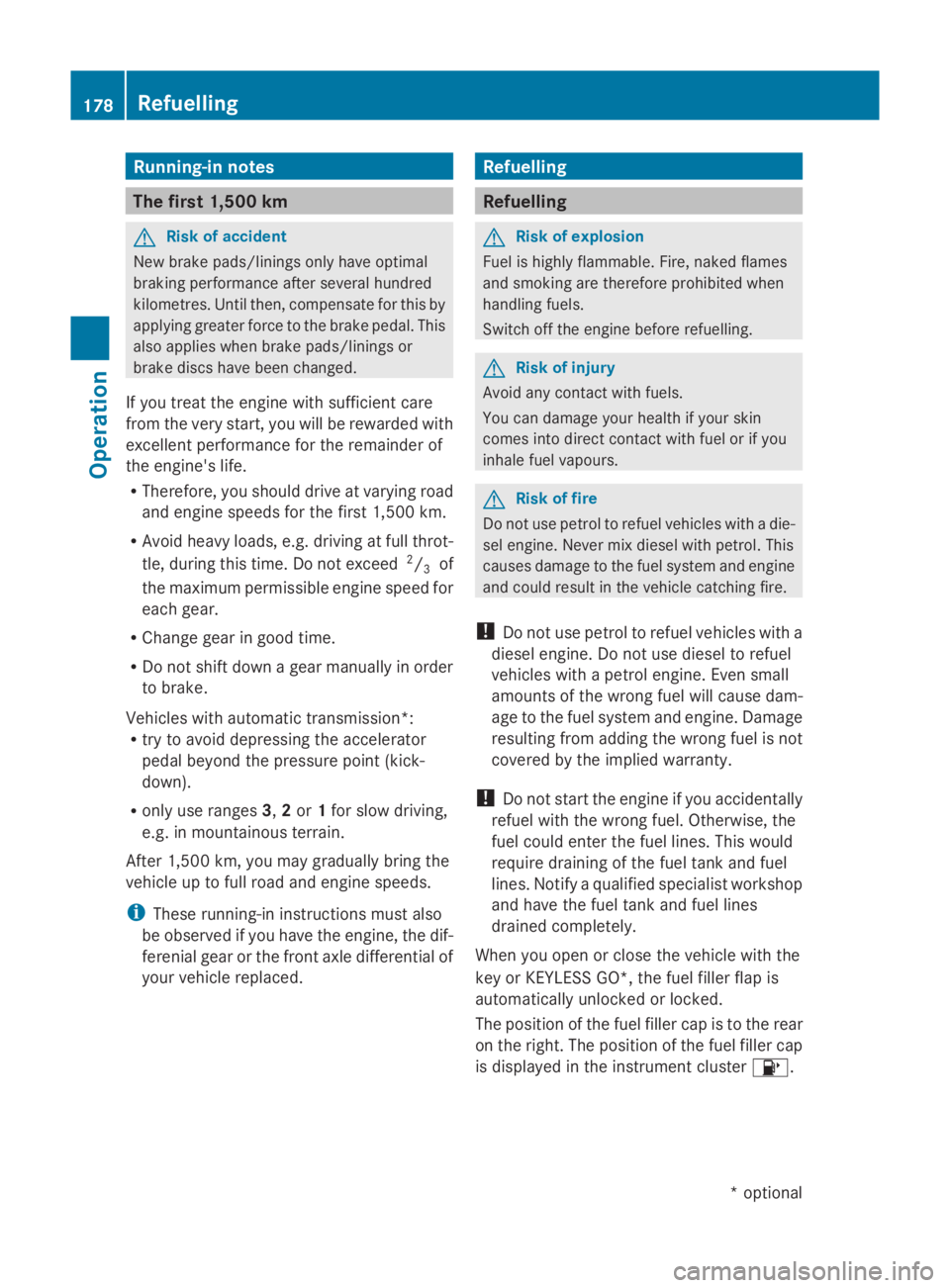
Running-i
nnotes The firs
t1,50 0km G
Ris
kofa ccident
New brake pads/linings only have optimal
braking performance afte rsevera lhun dred
kilometres. Until then, compensate for this by
applying greate rforce to the brake pedal .This
also applie swhenb rake pads/linings or
brake discs have bee nchanged.
If yo utrea tthe engine with sufficient care
from the very start, yo uwillber ewarded with
excellent performance for the remainder of
the engine's life.
R Therefore, yo ushoul ddrive at varying road
and engine speeds for the firs t1,500 km.
R Avoi dheavy loads, e.g. driving at ful lthrot-
tle, during this time .Donot exceed 2
/ 3 of
the maximum permissible engine speed for
each gear.
R Chang egearing oodt ime.
R Do not shift dow nagearm anually in order
to brake.
Vehicles with automatic transmission*:
R try to avoid depressing the accelerator
pedal beyond the pressure point (kick-
down).
R only us eranges 3,2or 1for slo wdriving,
e.g. in mountainou sterrain.
After 1,500 km ,you may gradually bring the
vehicl euptof ullr oa da nd engine speeds.
i These running-in instructions mus talso
be observe difyouhave the engine, the dif-
ferenia lgea rort he front axl edifferentia lof
your vehicl ereplaced. Refuelling
Refuelling
G
Ris
kofe xplosion
Fue lish ighly flammable. Fire ,nake dflames
and smoking are therefore prohibited when
handling fuels.
Switch off the engine before refuelling. G
Ris
kofi njury
Avoi dany contact with fuels.
Yo uc an damag eyourh ealth if your skin
come sinto direct contact with fue lorifyou
inhale fue lvapours. G
Ris
koff ire
Do not us epetrol to refuel vehicles with adie-
sel engine. Neve rmix diese lwithp etrol .This
causes damag etothe fue lsys tem and engine
and could resul tinthe vehicl ecatching fire.
! Do not us epetrol to refuel vehicles with a
diese lengine. Do not us ediese ltor efuel
vehicles with apetrol engine. Even small
amounts of the wrong fue lwillc ause dam-
ag etot he fue lsys tem and engine. Damage
resulting from adding the wrong fue lisnot
covered by the implied warranty.
! Do not star tthe engine if yo uaccidentally
refuel with the wrong fuel. Otherwise, the
fue lcould enter the fue llin es. Thi swould
require draining of the fue ltank and fuel
lines. Notify aquali fied specialist workshop
and have the fue ltank and fue llin es
draine dcompletely.
Whe nyou ope norc lose the vehicl ewitht he
key or KEYLESS GO*, the fue lfille rflapis
automaticall yunlocked or locked.
The position of the fue lfille rcap is to the rear
on the right. The position of the fue lfille rcap
is displayed in the instrument cluster 00B8.178
RefuellingOperation
*o
ptional
207_AKB; 2; 3, en-GB
mkalafa
,V ersion: 2.11.8.1
2009-07-23T10:23:49+02:00
-Seite 178
Page 192 of 313
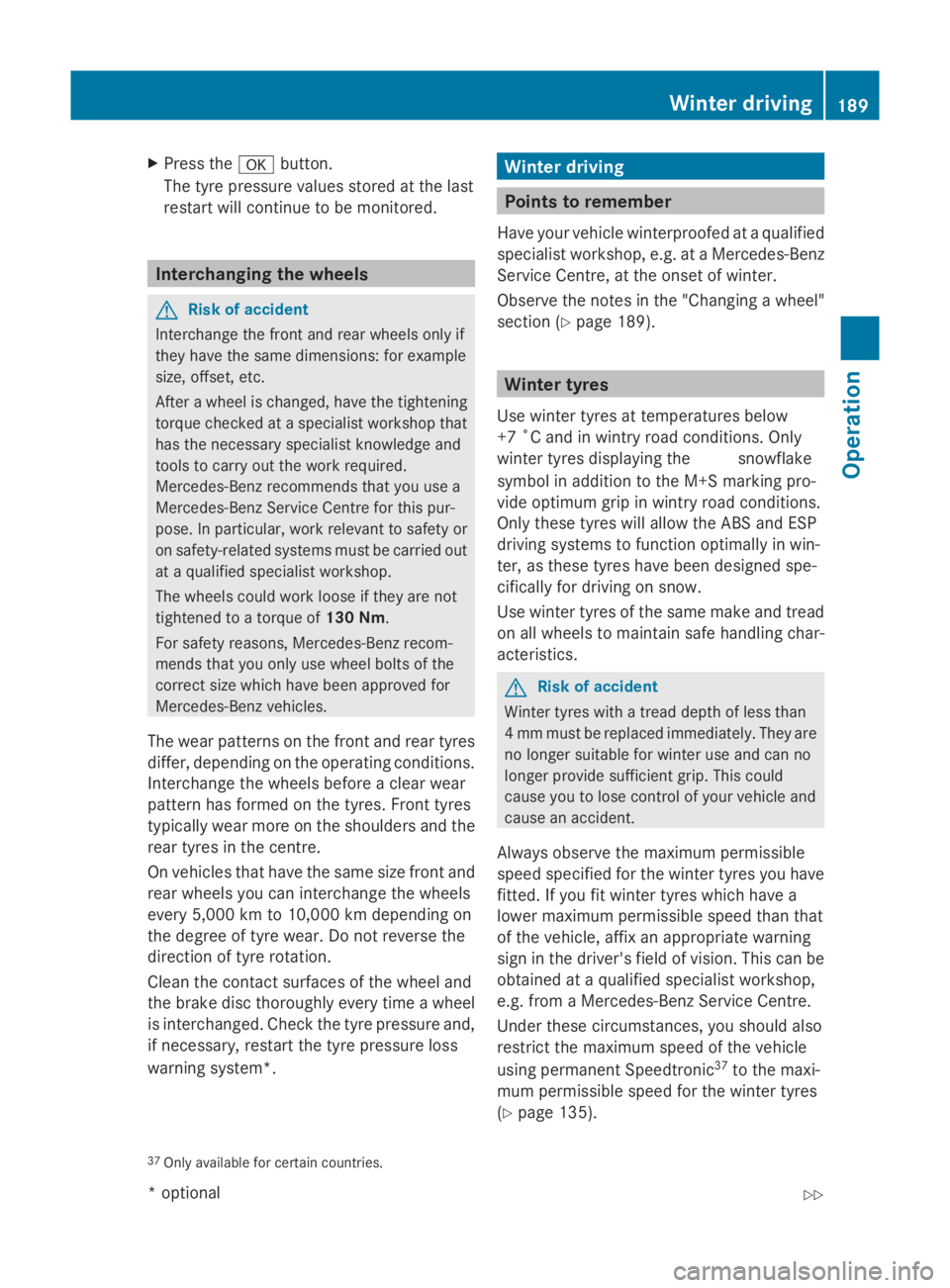
X
Press the 0064button.
The tyre pressure values stored at the last
restart will continue to be monitored. Interchanging the wheels
G
Risk of accident
Interchange the fron tand rear wheels only if
they have the same dimensions :for example
size, offset ,etc.
After awheel is changed, have the tightening
torque checked at aspecialist workshop that
has the necessary specialist knowledge and
tools to carry out the work required.
Mercedes-Benz recommends that you use a
Mercedes-Benz Servic eCentre for this pur-
pose. In particular, work relevant to safety or
on safety-related systems must be carried out
at aq ualified specialist workshop.
The wheels could work loose if they are not
tightened to atorque of 130 Nm.
For safety reasons, Mercedes-Benz recom-
mends that you only use wheel bolts of the
correc tsize which have been approved for
Mercedes-Benz vehicles.
The wear patterns on the fronta nd rear tyres
differ, depending on the operating conditions.
Interchange the wheels before aclear wear
patter nhas formed on the tyres. Frontt yres
typically wear more on the shoulders and the
rear tyres in the centre.
On vehicles that have the same size fronta nd
rear wheels you can interchange the wheels
every 5,000 km to 10,00 0kmdepending on
the degree of tyre wear. Do not reverse the
direction of tyre rotation.
Clean the contact surfaces of the wheel and
the brake disc thoroughly every time awheel
is interchanged. Check the tyre pressure and,
if necessary, restart the tyre pressure loss
warning system*. Winter driving
Points to remember
Have your vehicle winterproofed at aqualified
specialist workshop, e.g. at aMercedes-Benz
Servic eCentre, at the onset of winter.
Observe the notes in the "Changing awheel"
section (Y page 189). Winter tyres
Use winter tyres at temperatures below
+7 ˚C and in wintry road conditions. Only
winter tyres displaying the 004Dsnowflake
symbol in addition to the M+S markin gpro-
vide optimum grip in wintry road conditions.
Only these tyres will allow the ABS and ESP
driving systems to function optimally in win-
ter, as these tyres have been designed spe-
cifically for driving on snow.
Use winter tyres of the same make and tread
on all wheels to maintain safe handling char-
acteristics. G
Risk of accident
Winter tyres with atread depth of less than
4mmm ust be replaced immediately. They are
no longer suitable for winter use and can no
longer provide sufficient grip. This could
cause you to lose control of your vehicle and
cause an accident.
Always observe the maximum permissible
speed specified for the winter tyres you have
fitted. If you fit winter tyres which have a
lower maximum permissible speed than that
of the vehicle, affix an appropriate warning
sign in the driver's field of vision. This can be
obtained at aqualified specialist workshop,
e.g. from aMercedes-Benz Servic eCentre.
Under these circumstances, you should also
restrict the maximum speed of the vehicle
using permanen tSpeedtronic 37
to the maxi-
mum permissible speed for the winter tyres
(Y page 135).
37 Only available for certain countries. Winter driving
189Operation
*optional
207_AKB; 2; 3, en-GB
mkalafa,
Version: 2.11.8.1 2009-07-23T10:23:49+02:00-Seite 189 Z
Page 193 of 313
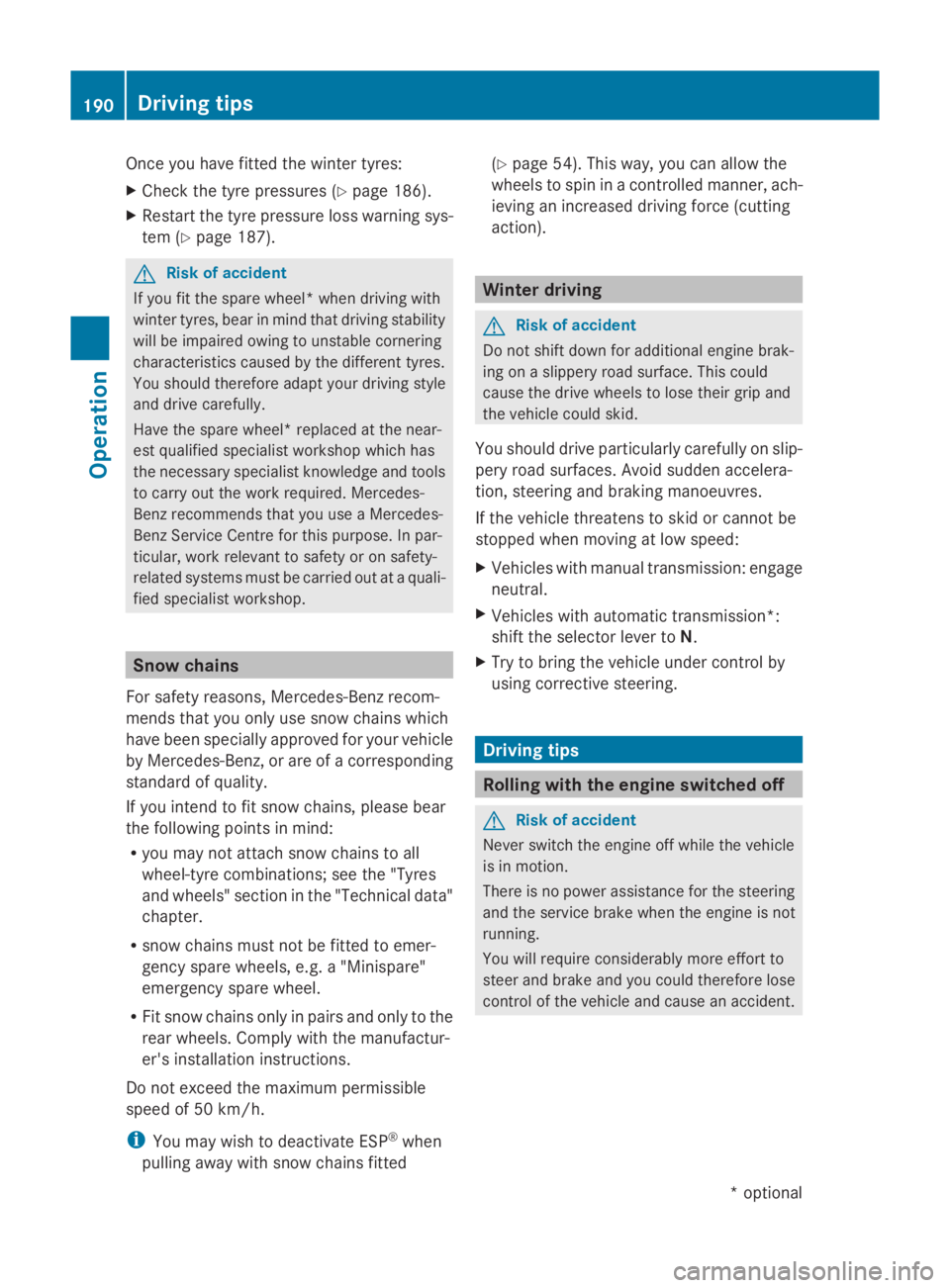
Once you have fitted the winter tyres:
X
Check the tyre pressures (Y page 186).
X Restart the tyre pressure loss warning sys-
tem (Y page 187). G
Risk of accident
If you fit the spare wheel* when driving with
winter tyres, bear in mind that driving stability
will be impaired owing to unstable cornering
characteristics caused by the different tyres.
You should therefore adapty our driving style
and drive carefully.
Have the spare wheel* replaced at the near-
est qualified specialist workshop which has
the necessary specialist knowledge and tools
to carry out the work required. Mercedes-
Benz recommends that you use aMercedes-
Benz Service Centre for this purpose. In par-
ticular, work relevant to safety or on safety-
related systems must be carried out at aquali-
fied specialist workshop. Snow chains
For safety reasons, Mercedes-Benz recom-
mends that you only use snow chains which
have been speciallya pproved for your vehicle
by Mercedes-Benz,ora re ofacorresponding
standard of quality.
If you intend to fit snow chains, pleaseb ear
the following points in mind:
R you may not attach snow chains to all
wheel-tyre combinations; see the "Tyres
and wheels" section in the "Technical data"
chapter.
R snow chains must not be fitted to emer-
gency spare wheels, e.g. a"Minispare"
emergency spare wheel.
R Fit snow chains only in pairs and only to the
rear wheels. Comply with the manufactur-
er's installation instructions.
Do not exceed the maximum permissible
speed of 50 km/h.
i You may wish to deactivate ESP ®
when
pulling awayw ith snow chains fitted (Y
page 54). This way,y ou can allowthe
wheels to spin in acontrolled manner, ach-
ieving an increased driving force (cutting
action). Winter driving
G
Risk of accident
Do not shift down for additional engine brak-
ing on aslippery road surface. This could
cause the drive wheels to lose their grip and
the vehicle could skid.
You should drive particularly carefully on slip-
pery road surfaces. Avoid sudden accelera-
tion, steering and braking manoeuvres.
If the vehicle threatens to skid or cannot be
stopped when moving at low speed:
X Vehicles with manual transmission: engage
neutral.
X Vehicles with automatic transmission*:
shift the selector lever to N.
X Try to bring the vehicle under control by
using corrective steering. Driving tips
Rolling with the engines
witchedoff G
Risk of accident
Never switch the engine off while the vehicle
is in motion.
There is no power assistance for the steering
and the service brake when the engine is not
running.
You will require considerably more effort to
steer and brake and you could therefore lose
control of the vehicle and cause an accident. 190
Driving tipsOperation
*o
ptional
207_AKB;2;3,e
n-GB
mkalafa, Version: 2.11.8.1 2009-07-23T10:23:49+02:00-Seite 190
Page 194 of 313

Brakes
G
Ris
kofa ccident
Do not change down for additional engine
braking on aslipper yroads urface. Thi scould
cause the drive wheels to lose thei rgripa nd
the vehicl ecould skid. G
Ris
kofa ccident
Make sure tha tothe rroa du sers are not
endangere dbyyourb raking.
Downhil lgradients On long and stee
pdownhil lstretches ,espe-
ciall yift he vehicl eisladen or towing atrailer,
yo um usts hift to alower gearing oodtime or,
on vehicles with automatic transmission*,
select shift range 1,2or 3.
i Thisalsoa pplies if youhavea ctivated
cruis econtrol, SPEEDTRONIC or DIS-
TRONIC PLUS*.
Thi sw illu se the braking effect of the engine,
so less braking will be required to maintain
the speed .Thisr elieves the load on the brake
system and prevents the brakes from over-
heating and wearing too quickly. If yo uneed
additional braking ,depress the brake pedal
repeatedly rather tha ncontinuously.
Heavy and light loads If the brakes have been subjected to
aheavy
load ,don ot stop the vehicl eimmediately, but
drive on for ashort while. Thi sallow sthe air-
flo wtoc oolthe brakes more quickly. G
Ris
kofa ccident
Never depress the brake peda lcontinuously
whil ethe vehicl eisinmotion, e.g .neve rcause
the brakes to ru bbyapplyingconstant slight
peda lpressure. Thi scauses the brake system
to overheat, increases the braking distance
and can lead to the brakes failing completely.
If the brakes have been used onl ymoderately,
yo us houl doccasionall ytest thei reffective-
ness .Todot his, brake more firmly from a highe
rspeed .Thisi mprove sthe gri pofthe
brakes.
Wet roads If driving in heavy rain for
aprolonged period
of time withou tbraking ,ther em aybe a
delaye dreactio nfrom the brakes when brak-
ing for the first time .Thism ayalso occu rafter
the vehicl ehasbeen washed.
Yo uh avetod epress the brake peda lmore
firmly .Maintain agreate rdistance from the
vehicl einfront.
After driving on awetroa dorh aving the vehi-
cle washed, brake firmly whil epayin gatten-
tio ntot he traffic conditions. Thi swaythe
brake discs will become warm, drying more
quickly, which will protect them against cor-
rosion.
Limite dbraking performanc eonsalt
treate droads G
Ris
kofa ccident
The laye rofsaltont he brake discs and the
brake pads/lining smaycause adelay in the
braking effect, resulting in asignificantly lon-
ger braking distance, which could lead to an
accident.
To avoid thi sdanger ,you should:
R occasionall ybrake carefully, withou tput-
ting othe rroa du sers at risk, when yo uare
driving on salte droads. Thi shelps to
remove any salt tha tmayhave started to
buil dupont he brake discs and the brake
pads/linings.
R maintain agreate rdistance to the vehicle
ahea dand drive with particula rcare.
R carefull yapply the brakes at the end of a
trip and immediatel yaftercommencing a
new trip ,sothats altr esidue sare removed
from the brake discs. Driving tips
191Operation
*optional
207_AKB; 2; 3, en-GB
mkalafa,
Version: 2.11.8.1 2009-07-23T10:23:49+02:00-Seite 191 Z
Page 195 of 313
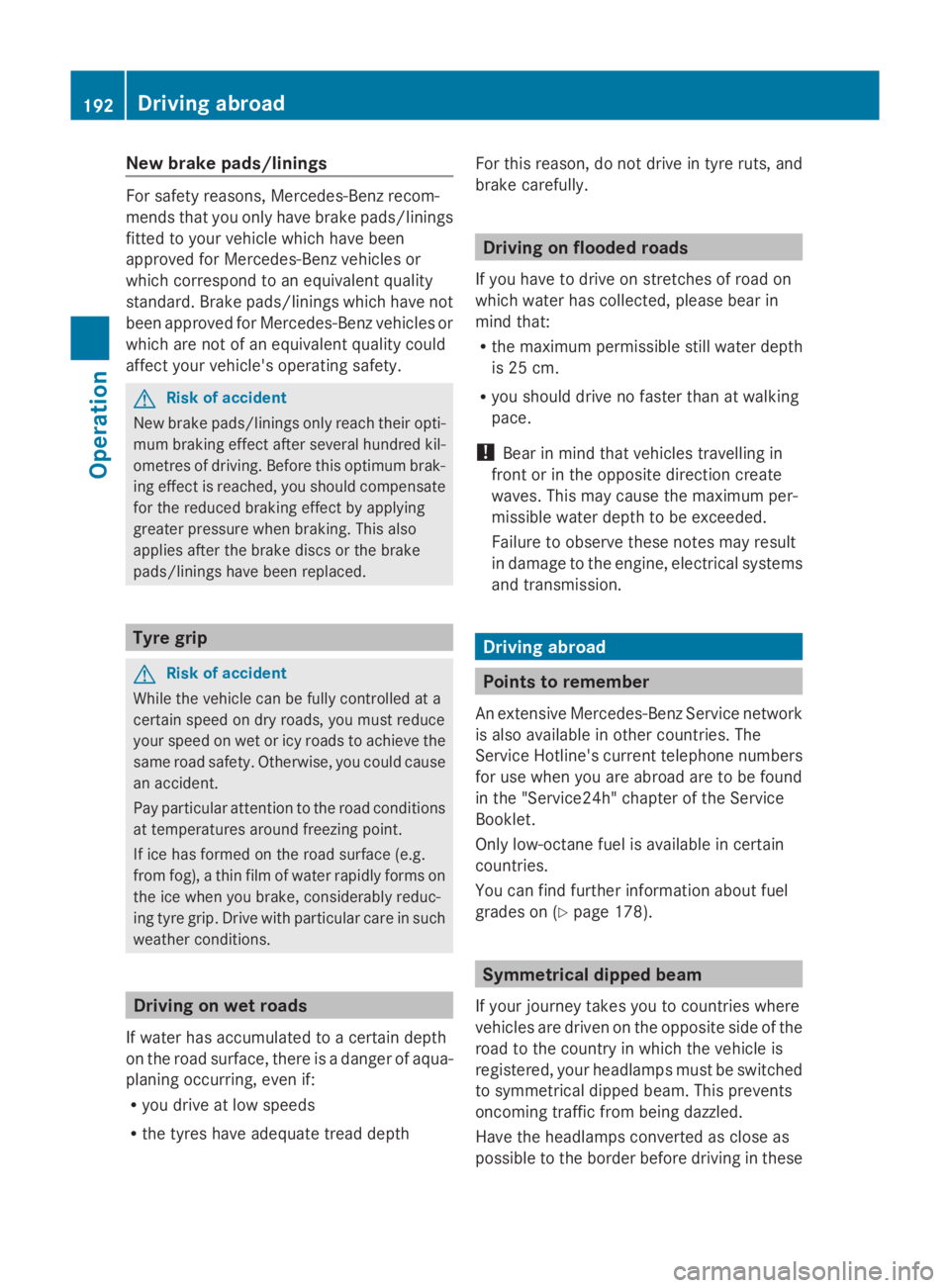
New brak
epads/linings For safety reasons, Mercedes-Benz recom-
mend
stha tyou onl yhaveb rake pads/linings
fitted to your vehicl ewhich have been
approved for Mercedes-Benz vehicles or
which correspond to an equivalent quality
standard. Brake pads/lining swhich have not
been approved for Mercedes-Benz vehicles or
which ar enot of an equivalent quality could
affec tyou rv ehicle' soperating safety. G
Ris
kofa ccident
New brake pads/lining sonlyr each their opti-
mu mb raking effect after several hundred kil-
ometres of driving. Before thi soptimum brak-
ing effect is reached, yo ushoul dcompensate
for the reduced braking effect by applying
greate rpressure when braking .Thisa lso
applie safter the brake discs or the brake
pads/lining shaveb eenr eplaced. Tyre grip
G
Ris
kofa ccident
Whil ethe vehicl ecan be full ycontrolle data
certai nspeed on dry roads ,you must reduce
your spee donwetor icy roads to achieve the
same roa dsafety .Otherwise, yo ucould cause
an accident.
Pa yp articula rattentio ntothe roa dconditions
at temperatures around freezing point.
If ice ha sformed on the roa dsurface (e.g.
fro mf og), athinf ilmofw ater rapidl yforms on
the ice when yo ubrake, considerabl yreduc-
ing tyr egrip. Drive with particula rcareins uch
weather conditions. Driving on we
troads
If water ha saccumulate dtoacertaindepth
on the roa dsurface, there is adangerofa qua-
planing occurring, eve nif:
R yo ud rive at lo wspeeds
R the tyres have adequate trea ddepth For thi
sreason, do not drive in tyr eruts, and
brake carefully. Driving on flooded roads
If yo uhavetod rive on stretche sofroadon
which water ha scollected ,pleas ebearin
mind that:
R the maximum permissibl estill water depth
is 25 cm.
R yo us houl ddrive no faste rtha natw alking
pace.
! Bea rinm indt hatv ehicles travelling in
front or in the opposite directio ncreate
waves .Thism aycause the maximum per-
missibl ewater depth to be exceeded.
Failur etoo bserve these note smayresult
in damage to the engine ,electrica lsys tems
and transmission. Driving abroad
Points to remember
An extensive Mercedes-Benz Service network
is also availabl einother countries .The
Service Hotline's current telephone numbers
for us ewheny ou area broa da reto be found
in the "Service24h" chapte rofthe Service
Booklet.
Onl ylow -octan efuelisa vailable in certain
countries.
Yo uc an find furthe rinformation abou tfuel
grade son(Ypage 178). Symmetrical dipped beam
If your journey take syou to countries where
vehicles ar edriven on the opposite side of the
roa dtot he country in which the vehicl eis
registered, your headlamps must be switched
to symmetrical dipped beam .Thisp revents
oncoming traffi cfromb eing dazzled.
Have the headlamps converte dasclose as
possibl etothe borde rbefor ed riving in these 192
Driving ab
roadOperation
207_AKB; 2; 3, en-GB
mkalafa, Version: 2.11.8.1 2009-07-23T10:23:49+02:00-Seite 192
Page 198 of 313

Coupling up
atrailer G
Ris
kofi njury
Do no tdisconnect atrailer wit hanengaged
overrun brake. Otherwise, your han dcould
become trapped between th ebumpe rand
trailer drawbar.
! Do no tdisconnect atrailer wit han
engaged overrun brake. Otherwise, your
vehicle could be damaged by th erebound-
ing of th eoverrun brake.
X Positio nthe trailer leve lbehin dthe vehicle.
X Couple up th etrailer.
X Establish th eelectrical connection
between th evehicle and th etrailer.
Driving tips G
Ris
kofa ccident
If the Check traile rhitch locking
mechanism message appear sinthemulti-
function display while th evehicle is in motion,
pull ove rimmediately and check whether the
ball couplin giscorrectly engaged.
i Observ ethe note sonE SP®
trailer stabi-
lisation (Y page 55).
In Germany, th emaximum permissible speed
for vehicle/trailer combinations depends on
th et ype of trailer and is either 80 km/h or
10 0k m/ h. In som ecountries ,higher maxi-
mum speeds are permissible for vehicle/
trailer combinations .Before beginnin gthe
journey, check th etrailer' sdocuments to see
what th emaximum permitted spee dis.
For certain Mercedes-Ben zvehicles, th emax-
imum permissible rear axle load is increased
when towing atrailer. Refer to th e"Technical
data" sectio ntofindo ut whether this applies
to your vehicle .Ifyou utilise any of th eadded
maximum rear axle load when towing atrailer,
th ev ehicle/trailer combinatio nmay not
excee damaximum spee dof100km/h for
reason sconcernin gthe operatin gpermit. This also applies in countries in whic
hthe
permissible maximum spee dfor vehicle/
trailer combinations is abov e100 km/h. G
Ris
kofa ccident
Always observ ethe maximum spee dpermit-
te dinG ermany for vehicle/traile rcombina-
tions ,eveninc ountries wher ehigher speeds
are permitted. This lower sthe riskofana cci-
dent.
When towing atrailer, your vehicle's handling
characteristic swill be different in comparison
to when driving without atrailer.
The vehicle/trailer combination:
R is heavier
R is restricted in its acceleratio nand gradi-
ent-climbin gcapability
R has an increased braking distance
R is affected mor ebystron gc rosswinds
R demands mor esensitive steering
R consumes mor efuel
On lon gand steep downhill gradients ,you
must selec talower gear in good time, or on
vehicle switha utomatic transmission*, select
shif trange 1,2or 3.
i This also applies if you have activated
cruise control, SPEEDTRONI CorDIS-
TRONIC PLUS*.
This will use th ebraking effect of th eengine,
so less braking will be required to maintain
th es peed. This relieves th eload on th ebrake
system and prevents th ebrakes from over-
heating and wearin gtoo quickly. If you need
additional braking ,depress th ebrak epedal
repeatedly rather than continuously. G
Ris
kofa ccident
Never depress th ebrak epedal continuously
while th evehicle is in motion ,e.g.n ever cause
th eb rakes to rub by applyin gconstant slight
pedal pressure .This causes th ebrak esystem
to overheat, increases th ebraking distance
and can lead to th ebrakes failin gcompletely. Trailer towing*
195Operation
*o
ptional
207_AKB
;2;3,en-GB
mkalafa ,V ersion: 2.11.8.1
2009-07-23T10:23:49+02:00
-Seite 195 Z
Page 199 of 313
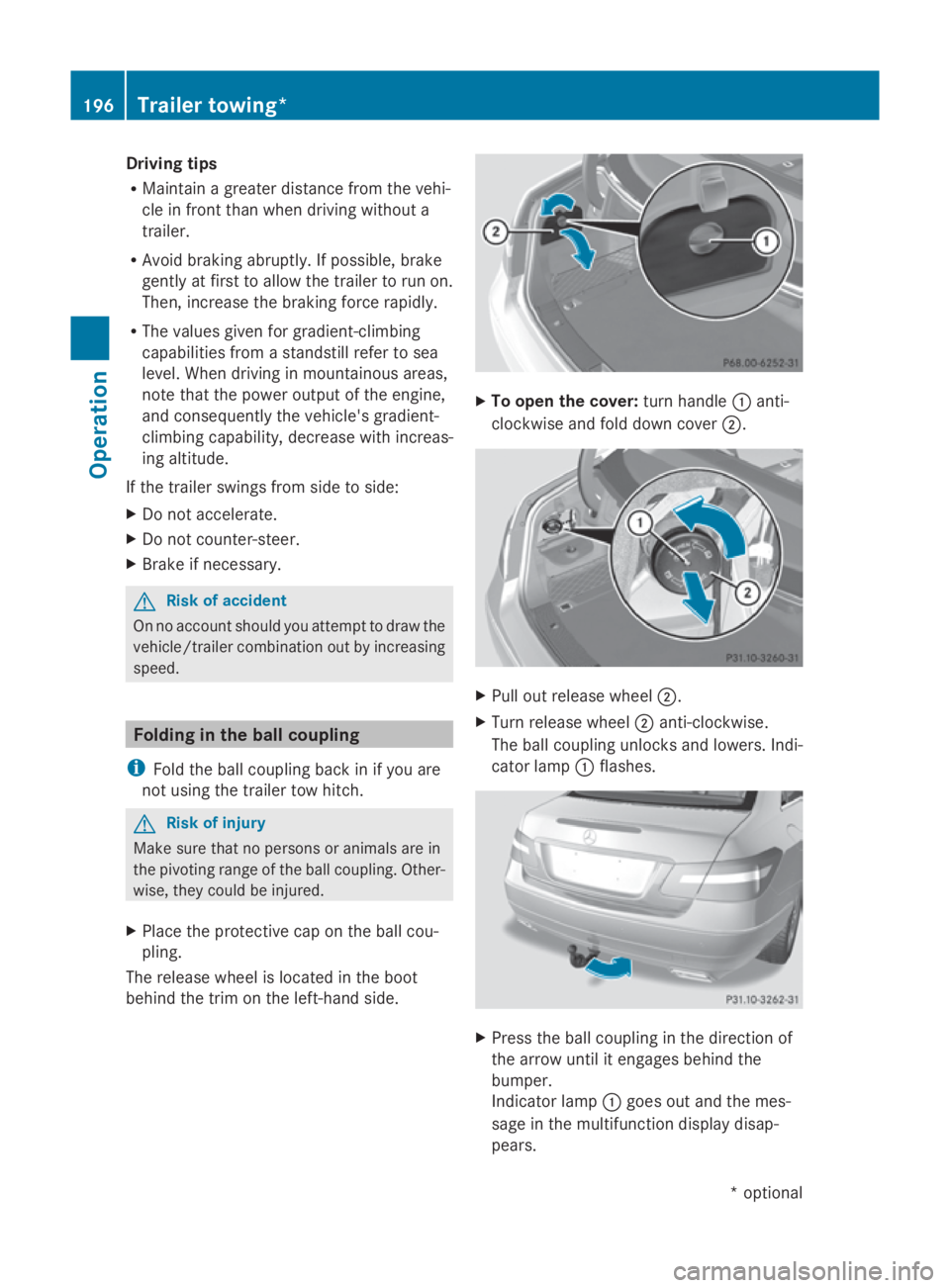
Driving tips
R
Maintai nagreate rdistanc efromt hevehi-
cle in fron ttha nw hen drivin gwithout a
trailer.
R Avoid brakin gabruptly. If possible, brake
gentl yatfirst to allow th etrailer to run on.
Then, increase th ebrakin gforce rapidly.
R The value sgiven fo rgradient-climbing
capabilities from astandstill refer to sea
level. Whe ndrivin ginm ountainous areas,
note that th epowe routput of th eengine,
and consequentl ythe vehicle's gradient-
climbing capability, decreas ewithi ncrea s-
in ga ltitude.
If th etrailer swings from side to side:
X Do no taccelerate.
X Do no tcounter-steer.
X Brake if necessary. G
Risk of accident
On no accoun tshould you attemp ttodraw the
vehicle/trailer combination out by increasing
speed. Folding in th
eballc oupling
i Fold th eball couplin gbackinify ou are
no tu sin gthe trailer to whitch. G
Risk of injury
Mak esuret hatnop ersonsoranimals are in
th ep ivotin grange of th eball coupling. Other-
wise ,the yc ould be injured.
X Plac ethe protective cap on th eball cou-
pling.
The release whee lislocate dintheboot
behin dthe trim on th eleft-han dside. X
To ope nthe cover: turnh andle 0046anti-
clockwise and fold down cover 0047. X
Pull out release wheel 0047.
X Tur nrelease wheel 0047anti-clockwise.
The ball couplin gunlocks and lowers .Ind i-
cator lamp 0046flashes. X
Press th eball couplin ginthedirection of
th ea rrow until it engage sbehin dthe
bumper.
Indicato rlamp 0046goe sout and th emes-
sage in th emultifunction display disap-
pears. 196
Trailer towing*Operation
*optional
207_AKB; 2; 3, en-GB
mkalafa,
Version: 2.11.8.1 2009-07-23T10:23:49+02:00-Seite196
Page 201 of 313

service.
Anumber or another letter may be
displayed after the letter. This figure indicates
any necessary additional maintenance work
to be performed. If you report this displayed
information to aqualified specialist work-
shop, for example aMercedes-Benz Service
Centre, they can inform you of the costs the
service will incur.
The ASSYST PLUS service interval display
does not take into account any periods of
time during which the battery is disconnec-
ted. To maintain the time-dependent service
schedule:
X Note down the service due date displayed
before disconnecting the battery.
or
X Subtract the battery disconnection periods
from the service date shown on the display
after reconnecting the battery.
Hiding aservice message X
Press 0041or0064.
Service overdue Ad
isplaym essage is shown in the multi-func-
tion display, for example:
Service Aoverdue by ... days
Service Aoverdue by .. km
i If you fail to have the service performed
by the specified date, you may be violating
applicable laws. Your warranty may be inva-
lidated and goodwills ettlementsmay be
refused.
Callingupa service due date X
Switch on the ignition.
X Press the 0040or003E button to select the
Service menu.
X Press the 003Cor003D button to select the
ASSYST PLUS submenu and confirm with
0064.
The multi-function displays hows the
service due date. Care
Care and cleaning products
Regular care of your vehicle is acondition for
retaining the quality in the long term.
Use only care products and cleaning agents
recommended and approved by Mercedes-
Benz.
! For cleaning your vehicle, do not use any
of the following:
R dry, rough or hard cloths
R abrasive cleaning agents
R solvents
R cleaning agents containing solvents
and do not scrub.
Do not touch the surfaces and protective
films with hard objects, e.g. rings or ice
scrapers. You could otherwise scratch or
damage the surfaces and protective film. H
Environmental note
Dispose of empty packaging, cleaning cloths
and polishing wads in an environmentally
responsible manner.
! Do not park the vehicle for along period
of time directly after cleaning, especially if
the wheels have just been cleaned with a
wheel cleaner. Wheel cleaners could cause
rapid corrosion of the brake discs and
brake pads/linings. After cleaning, park
the vehicle when it is at normal operating
temperature. Exterior care
Automatic car wash G
Risk of accident
The vehicle is braked when the HOLD function
or DISTRONIC PLUS* is activated. Therefore,
deactivate the Hold function or DISTRONIC
PLUS before the vehicle is washed in an auto-
matic car wash. 198
CareOperation
*o
ptional
207_AKB;2;3,e
n-GB
mkalafa, Version: 2.11.8.1 2009-07-23T10:23:49+02:00-Seite 198